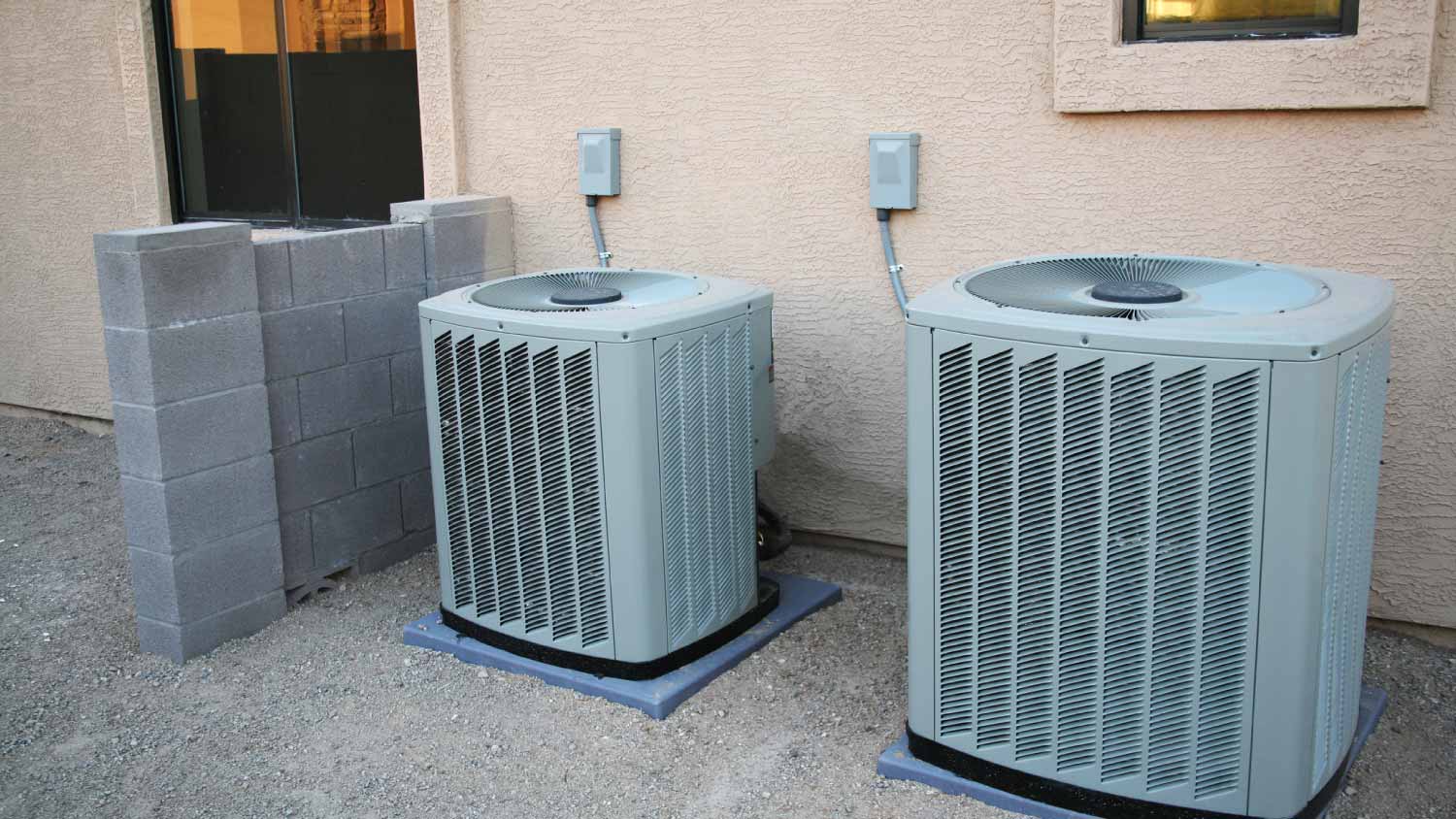Central Air vs. Forced Air: What’s the Difference?
Keep your home cool in the summer and warm in the winter with the correct air system


Central air provides high efficiency and quiet operation.
Forced air offers energy efficiency and lower energy bills.
Both central air and forced air require the same maintenance schedule.
If you want to install or upgrade your heating and air conditioning systems, you’ve probably heard about central air vs. forced air. Although some people use the two terms interchangeably, there are several differences between the two types of systems. If you need assistance choosing which option is right for your home, consider hiring an AC installer to get a professional opinion. Luckily, our guide will break down everything you need to know about central air vs. forced air to decide which system is right for you.
Central Air vs. Forced Air: Key Differences
Central air refers to your home’s air conditioning system, and forced air refers to your home’s heating system. Forced air is also the air distribution system that allows heat and cool air to travel through ducts and vents, circulating air throughout your home.
Central air and forced air are associated with different indoor and outdoor systems. Central air is for outside air conditioning units, and forced air is for indoor furnaces and heat pumps. Hire a local AC installer to help you choose and install the right system for your home.
What Is Central Air?

Central air systems pull hot air in and release cold air through the vents and ductwork in your home. Central air systems use a compressor, condenser, and evaporator coils to take in recycled air and produce cool air.
| Pros | Cons |
|---|---|
| Highly efficient | Expensive to install |
| Quiet operation | Requires annual maintenance |
| Easy temperature control | Potential for higher energy bills |
| Cleaner air quality | Requires ductwork installation if you don’t already have the ducts |
Best for:
Homeowners that want consistent year-round temperature control.
Households that need to filter out allergies and germs.
Homeowners looking for an easy-to-maintain unit.
Pros of Central Air
High efficiency: Central air systems last 10 to 15 years at full capacity with regular maintenance. So, you can rest easy knowing that your home will remain cool during the warm summer months.
Operates quietly: Since the central air conditioning unit is outside, it operates much quieter than a forced air system. However, when the central air conditioning unit is in operation, it is normal to hear a regular humming sound.
Easy temperature control: Because central air systems move through ducts and vents, they maintain a consistent temperature in your home throughout the year. You can easily install different types of thermostats to ensure your home stays warm in the winter and cool in the summer.
Cleaner air quality: Central air systems constantly filter recycled air through your ducts and air filters—and in this process, the system filters out allergens, gases, dust mites, pet dander, and airborne particles. This feature is a huge benefit for homeowners who suffer from asthma and allergies.
Cons of Central Air
Expensive to install: Central air systems can be costly, especially if you don’t have a furnace to share the ducts and vents. In addition, you’ll need to hire a certified HVAC technician to ensure the installation is done correctly.
Requires annual maintenance: To keep your central air system in good working condition for many years, you’ll need yearly maintenance. For an annual HVAC tuneup, you can expect to pay between $160 and $400. For air duct cleaning, you’ll pay anywhere from $270 to $500.
Higher energy bills: If you don’t set your air conditioning unit above 72 degrees, you’ll likely incur higher energy bills because the unit has to work much harder to keep your home cool. The more time the air conditioner runs, the higher your electrical bills.
Requires new ductwork installation: If your home isn’t equipped with forced air ducts, you’ll need to install new ductwork. You can expect to pay between $1 and $13 per linear foot or an average cost of $3,500 for ductwork installation.
What Is Forced Air?

Forced air systems are associated with heat pumps and furnaces. Forced air systems use vents and ducts to send warm air throughout your home. These systems also connect with your HVAC unit and provide cool air through the same vents and ducts in the summer.
| Pros | Cons |
|---|---|
| Provides filtered air | Expensive installation |
| Lower energy bills | Noisy system |
| Adds value to your home | Requires annual maintenance |
| Heating efficiency | Uneven heating is possible |
Best for:
Homeowners who want their house to heat up quickly and effectively.
Those looking for energy-efficient ways to heat their home.
Homeowners who want a long-lasting heating system.
Pros of Forced Air
Provides filtered air: Forced air travels through filters in your system, which keeps dust, pet dander, particles, bacteria, viruses, and mold from entering your home through ducts and vents.
Results in lower energy bills: Modern forced air systems are highly energy efficient, with less than 5% of fuel getting lost during heating. According to a press release from the White House, homeowners can save up to $500 per year in energy bills with an energy-efficient heat pump.
Adds value to your home: A forced air system, complete with duct and vent work, will add value to your home when it comes time to sell. Home buyers seek energy efficiency and cost savings, so you’ll have a leg up on the competition.
Provides heating efficiency: Forced air units are compatible with smart and programmable thermostats. You can program your home’s forced air system for even more energy efficiency.
Cons of Forced Air
Expensive installation: Forced air systems are expensive, especially if you combine a forced air unit with a central air unit. However, the savings over time is worth the initial higher installation cost.
Noisy system: Because the furnace or heat pump is inside your home, the system can be noisy when operating.
Requires annual maintenance: Forced air systems can last up to 30 years with proper maintenance and repairs. You can expect an annual furnace inspection to cost $80 to $200. A yearly heat pump tuneup will cost $50 to $180.
Possibility of uneven heating: Forced air requires proper installation and regular maintenance. That’s why it’s important to hire an HVAC contractor in your area to clean your ducts annually. Without proper cleaning and sealing, you could end up with dirt, debris, mold, and mildew filtering through, which could negatively affect the performance of your system.
Central Air vs. Forced Air
Appearance: Tie
Central air and forced air both come out on top because their main functions are through ducts and vents. Unlike a mini split air conditioner hanging on the wall or ceiling, a furnace is in the basement or closet. The air conditioning unit is outside—essentially out of sight and mind.
Options and Customizations: Forced Air
Forced air offers more choices in terms of fuel sources. You can choose to heat your home from natural gas, electric, propane, or oil.
Price: Tie
The initial installation cost for a forced air system or a central air system will be costly due to the need for extensive ductwork and venting. However, adding a central air unit will cost much less if you have an established forced air system. If you need to replace your furnace, you’ll likely need to replace your air conditioner, too. In this case, you’ll save on labor costs.
Ease of Installation: Tie
Both central air and forced air systems require a skilled professional for installation. You’ll want to find a top air conditioner installer near you for this job—this way, you’ll have peace of mind knowing that your system is installed properly and will function correctly for many years to come.
Ease of Repair: Forced Air
You can expect the cost of furnace repair to run between $132 and $500, whereas the cost of HVAC repairs runs from $130 to $2,000. Typically, forced air repairs and parts cost less than central air parts. For example, replacing a compressor on an HVAC unit will cost $2,000. Air conditioning units may also encounter freon leaks, and that repair will cost between $75 and $200 for inspection only.
Maintenance: Tie
Both central air and forced air systems require annual maintenance and tune-ups to keep the system running smoothly. Additionally, since both systems share the same network of ducts and vents, they require special duct cleaning and sealing to prevent mold, mildew, bacteria, and dirt buildup.
Length of Life: Forced Air
While both forced air and central air have long-lasting capabilities with the proper maintenance and repairs, a forced air furnace can last up to 30 years. In contrast, the average central air unit lasts 10 to 15 years.
Sustainability: Forced Air
Forced air systems are becoming more sustainable and eco-friendly, especially if you install a modern heat pump or furnace. You have several different fuel choices, and you can also install zoned heating, allowing for temperature control in various parts of your home.
Resale Value: Tie
Homeowners are looking for ease, comfort, eco-friendliness, and cost-efficiency when purchasing a home. Both forced air and central air offer easy heating and cooling features and the option to tap into smart or programmable thermostats. Plus, homeowners save thousands of dollars in initial installation costs with the existing ductwork.





- Furnace Repair
- Air Conditioning Repair
- HVAC Repairs
- Furnace Installation
- Wood & Pellet Stove Repair
- Dehumidifier & Humidifier Repair
- Heat Pump Companies
- Swamp Cooler Repair
- Wood Stove Services
- HVAC Companies
- Commercial A/C Repair
- Geothermal Installation
- Air Conditioning Installation
- Boiler Repair
- 24 Hour Furnace Repair
- Geothermal Repair
- Heat Pump Repair
- Humidifier Installation
- Thermostat Repair
- Thermostat Installation
- Nest Installation
- Heating & Cooling
- Heating Repair
- Furnace Cleaning
- Furnace Tune-Up
- HVAC Technicians
- Subcontractors
- Furnace Maintenance
- Plumbing & Heating Companies
- Wood Stove Inspection
- Mini Split Installation
- Wall Heater Repair
- Duct Installers










